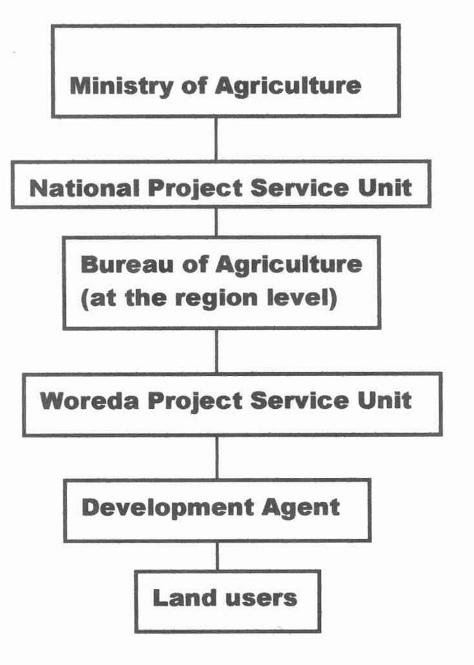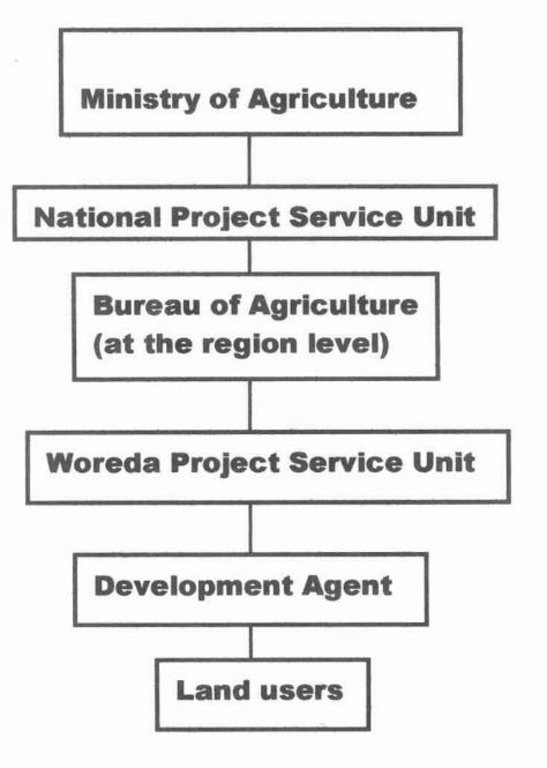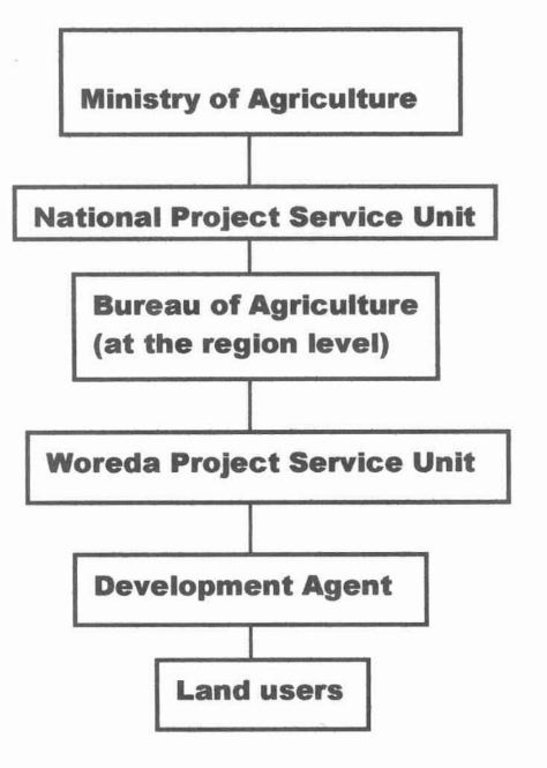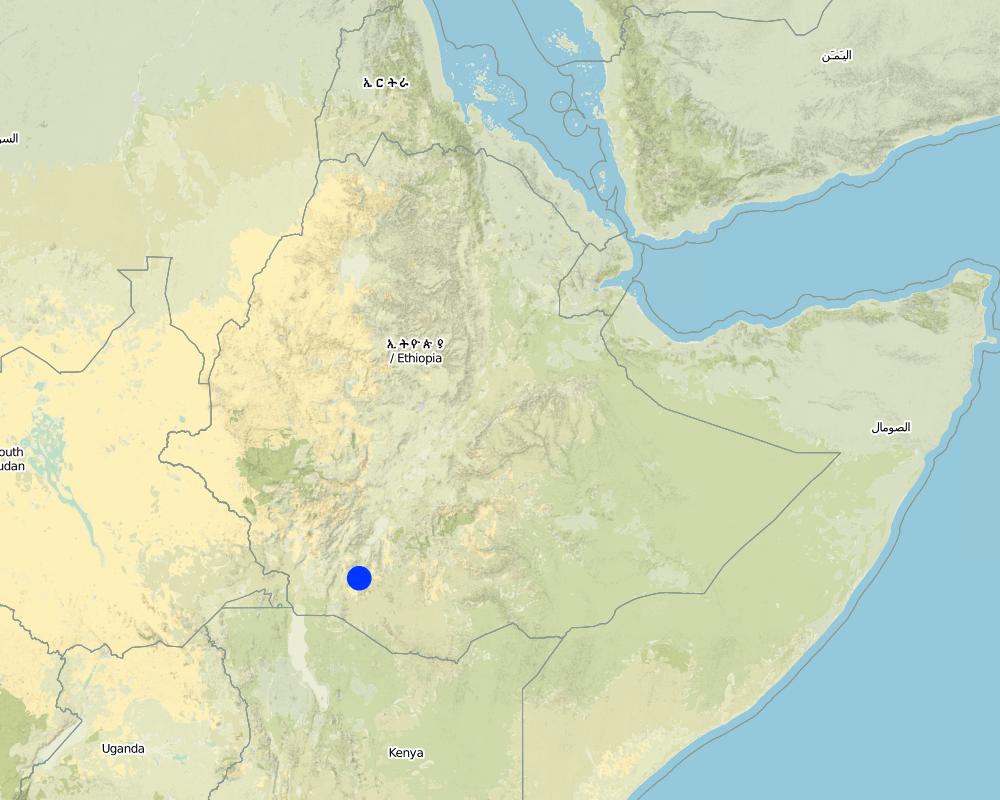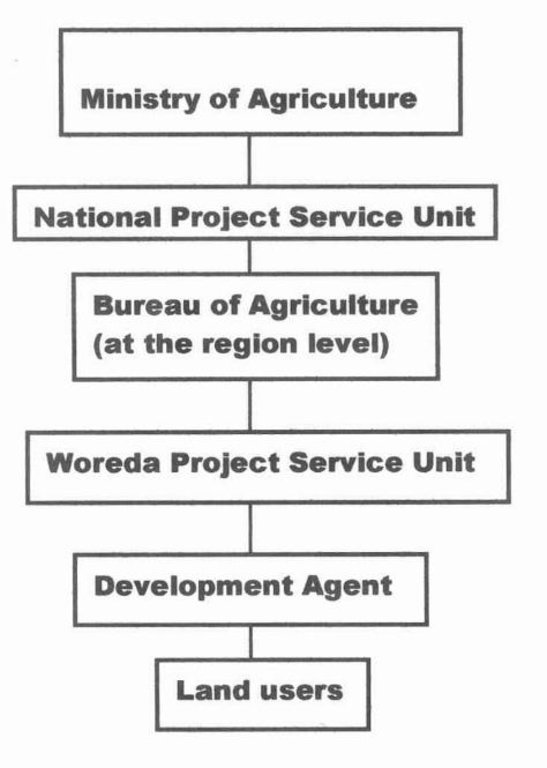Local Level Participatory Planning Approach (LLPPA) [أثيوبيا]
- تاريخ الإنشاء:
- تحديث:
- جامع المعلومات: Philippe Zahner
- المحرر: –
- المُراجع: Fabian Ottiger
approaches_2389 - أثيوبيا
عرض الأقسام
توسيع الكل طي الكل1. معلومات عامة
1.2 تفاصيل الاتصال بالأشخاص الرئيسيين لمصدر المعلومات والمؤسسات المعنية بتقييم وتوثيق النهج
اسم المؤسسة (المؤسسات) التي سهلت توثيق/تقييم النهج (إذا كان ذلك على صلة)
Swiss Agency for Development and Cooperation (DEZA / COSUDE / DDC / SDC) - سويسرا1.3 الشروط المتعلقة باستخدام البيانات الموثقة من خلال WOCAT
يوافق جامع المعلومات والشخص (لاشخاص) الرئيسي لمصدر المعلومات على الشروط المتعلقة باستخدام البيانات الموثقة من خلال WOCAT:
نعم
1.4 المراجع الخاصة باستبيان(استبيانات) تقنيات الإدارة المستدامة للأراضي

Terrasses en banquettes Konso [أثيوبيا]
Un talus en pierres selon les courbes du niveau en nivelant progressivement la terre entre deux niveaux afin de contrôler l'érosion du sol.
- جامع المعلومات: Daniel Danano
2. وصف نهج الإدارة المستدامة للأراضي
2.1 وصف موجز للنهج
It is food for work based participatory approach, by which the land users takes part in all stages of conservation planning, implementation and evaluation.
2.2 وصف تفصيلي للنهج
وصف تفصيلي للنهج:
Aims / objectives: The overall purpose of the approach is to achieve better SWC through promotion of participation, Awarness creation, better organization and better planning. The specific objective of the approach is to provide solutions for Top down approach, to achieve better quality work, to achieve better participation, to achieve better planning, implementation, monitoring and evaluation.
Methods: There are different methods involved in the approach, to mention some: Wealth ranking, Vulnerability assessment and mapping.
Stages of implementation: The stages of implementations are planning, implenentation, monitoring and evaluation.
Role of stakeholders: The roles of the participants are sharing their views and opinions on the resources management and they contribute the full labour required for the activities.
2.3 صور عن النهج
2.5 البلد/المنطقة/المواقع التي تم تطبيق النهج فيها
البلد:
أثيوبيا
المنطقة/الولاية/المحافظة:
SNNPR
Map
×2.6 تواريخ بدء وإنهاء تنفيذ النهج
أشر إلى سنة البدء:
1978
2.7 نوع النهج
- قائم على مشروع/برنامج
2.8 الغايات/الأهداف الرئيسية للنهج
The Approach focused on SLM only
Facilitate better achievments of SWC through promotion of participation, awarness creation, better organization, training skill upgrading and better planing
The SLM Approach addressed the following problems: Topdown approach, poor participation and integration, poor planning, low quality of conservation activities and low level of awareness
2.9 الظروف التي تمكن أو تعيق تنفيذ التقنية/التقنيات المطبقة بموجب النهج
المعايير والقيم الاجتماعية /الثقافية/ الدينية
- معيق
Low level of awarness, cultural taboos and poor participation (especially for women)
Treatment through the SLM Approach: Awarness creation activities have been promoted using different methods
توفر/الوصول إلى الموارد والخدمات المالية
- معيق
Lack of budget (for ttraining and petty cash)
Treatment through the SLM Approach: By project funding and through income generating activities
الإطار المؤسساتي
- معيق
Office and staff shortage
Treatment through the SLM Approach: Enough staff should be recurited and offices should be constructed
الإطار القانوني (حيازة الأراضي، وحقوق استخدام الأراضي والمياه)
- معيق
Absence of policies on the appropraite use of natural resources
Treatment through the SLM Approach: Proper polcy formulation
المعرفة حول الإدارة المستدامة للأراضي، والوصول إلى الدعم الفني
- معيق
Shortage of skilled manpower and absence of educated farmer
Treatment through the SLM Approach: Short and long term training
3. المشاركة وأدوار الأطراف المعنية
3.1 أصحاب المصلحة المعنيون بالنهج وأدوارهم
- مستخدمو الأراضي المحليون/المجتمعات المحلية
Working land users were mainly men (The conservation activities like Bench Terraces are considered heavly and labourious and mainly done by men whereas nursery activities are equally divided)
Local traditional men are considered as hard worker and labourious SWC activities are mainly done by men. Tedious works like bench terraces, ridge and basin etc. are mainly done by men. Less tedious activities like pitting, potting and planting are done by women and men equally. Farmers with very small land holdings participate during general LLPPA meetings
- الحكومة الوطنية (المخططون، صانعو القرار)
Ministry of Agriculture
- منظمة دولية
WFP (World Food Programme)
إذا كان هناك العديد من الأطراف المعنية، قم بالإشارة إلى الوكالة الرائدة:
The National and international SWC specialists together modified the minimum planning approach to LLPPA
3.2 انخراط مستخدمي الأراضي المحليين/المجتمعات المحلية في المراحل المختلفة للنهج
| انخراط مستخدمي الأراضي المحليين/المجتمعات المحلية | حدد من شارك وصف الأنشطة | |
|---|---|---|
| المبادرة/التحفيز | تفاعلي | Mainly:LLPPA; partly: public meetings |
| التخطيط | تفاعلي | Mainly: LLPPA; partly: public meetings |
| التنفيذ | الدعم الخارجي | responsibility for major steps |
| الرصد/التقييم | غير موجود | |
| Research | غير موجود |
3.3 مخطط التدفق (إذا كان متاحًا)
3.4 اتخاذ القرار بشأن اختيار تقنية/تقنيات الإدارة المستدامة للأراضي
حدد من الذي قرر اختيار التقنية/التقنيات التي سيتم تنفيذها:
- مستخدمو الأراضي بشكل أساسي، بدعم من متخصصي الإدارة المستدامة للأراضي
اشرح:
consultative
Decisions on the method of implementing the SLM Technology were made by mainly by land users supported by SLM specialists. consultative
4. الدعم الفني وبناء القدرات وإدارة المعرفة
4.1 بناء القدرات/التدريب
هل تم تقديم التدريب لمستخدمي الأراضي / الأطراف المعنيين الآخرين؟:
نعم
حدد من تم تدريبه:
- مستخدمو الأراضي
- SWC specialists
شكل التدريب:
- في العمل
- من مزارع إلى مزارع
المواضيع المغطاة:
Planning, skill upgrading and technical training on SWC
4.2 خدمة استشارية
هل يملك مستخدمو الأراضي وصولا إلى خدمة استشارية؟:
نعم
حدد ما إذا كانت الخدمة الاستشارية متوفرة:
- في حقول مستخدمي الأراضي
وصف/تعليقات:
1) Advisory service was carried out through: government's existing extension system; Extension staff: mainly government employees
Advisory service is inadequate to ensure the continuation of land conservation activities; in relation to SWC the extension is weak and it is crop biased
4.3 تعزيز المؤسسات (التطوير التنظيمي)
هل تم إنشاء أو تعزيز مؤسسات من خلال هذا النهج؟:
- نعم، باعتدال
حدد المستوى (المستويات) التي تم فيها تعزيز أو إنشاء المؤسسات:
- محلي
حدد نوع الدعم:
- مالي
- بناء القدرات/التدريب
- معدات
4.4 الرصد والتقييم
هل يشكل الرصد والتقييم جزءا من النهج؟:
نعم
التعليقات:
bio-physical aspects were ad hoc monitored through observations
technical aspects were regular monitored through measurements
socio-cultural aspects were ad hoc monitored through observations
area treated aspects were monitored through observations
no. of land users involved aspects were monitored through measurements
There were several changes in the Approach as a result of monitoring and evaluation: As a result of monitoring and evaluation the quality of work improved. Exotic SWC techniques which fits to the local conditions has been incorporated.
5. التمويل والدعم المادي الخارجي
5.1 الميزانية السنوية لمكون الإدارة المستدامة للأراضي في النهج المذكور
التعليقات (على سبيل المثال المصادر الرئيسية للتمويل/الجهات المانحة الرئيسية):
Approach costs were met by the following donors: international (UN-FFW Ethiopia): 70.0%; government (national Ethiopian Government): 30.0%
5.2 الدعم المالي/المادي المقدم لمستخدمي الأراضي
هل حصل مستخدمو الأراضي على دعم مالي/ مادي لتنفيذ التقنية/ التقنيات؟:
نعم
5.3 إعانات لمدخلات محددة (بما في ذلك العمالة)
- معدات
| حدد المدخلات التي تم دعمها | إلى أي مدى | حدد الإعانات |
|---|---|---|
| أدوات | ممول جزئيا | Hand tools |
- زراعة
| حدد المدخلات التي تم دعمها | إلى أي مدى | حدد الإعانات |
|---|---|---|
| بذور | ممول جزئيا | |
إذا كان العمل من قبل مستخدمي الأراضي مدخلاً جوهريًا، فهل كان:
- الغذاء مقابل العمل
5.4 الائتمان
هل تم توفير ائتمان في إطار نهج أنشطة الإدارة المستدامة للأراضي؟:
كلا
6. تحليل الأثر والتصريحات الختامية
6.1 آثار النهج
هل ساعد النهج مستخدمي الأراضي على تنفيذ وصيانة تقنيات الإدارة المستدامة للأراضي؟:
- لا
- نعم، قليلا
- نعم، باعتدال
- نعم، إلى حد كبير
modified the traditional one to fit into the modern ones.
هل أدى النهج إلى تحسن في مسائل حيازة الأراضي / حقوق المستخدمين التي أعاقت تنفيذ تقنيات الإدارة المستدامة للأراضي؟:
- لا
- نعم، قليلا
- نعم، باعتدال
- نعم، إلى حد كبير
Did other land users / projects adopt the Approach?
- لا
- نعم، قليلا
- نعم، باعتدال
- نعم، إلى حد كبير
6.3 استدامة أنشطة النهج
هل يمكن لمستخدمي الأراضي المحافظة على استدامة ما تم تنفيذه من خلال النهج (بدون دعم خارجي)؟:
- غير مؤكد
6.4 نقاط قوة/مزايا النهج
| نقاط القوة/ المزايا/ الفرص من وجهة نظر مستخدمي الأراضي |
|---|
| Better acess to decision making (How to sustain/ enhance this strength: By empowering) |
| Skill upgrading (How to sustain/ enhance this strength: more training) |
| FFW incentive |
| نقاط القوة/ المزايا/ الفرص من وجهة نظر جامع المعلومات أو غيره من الاشخاص الرئيسيين لمصدر المعلومات |
|---|
| Participatory nature (How to sustain/ enhance this strength: By further empowering the local community) |
| Capacity builiding efforts (How to sustain/ enhance this strength: By giving more training and skill upgrading) |
| Awarness raising (How to sustain/ enhance this strength: By giving more training and skill upgrading) |
6.5 نقاط الضعف/ العيوب في المنهج وطرق التغلب عليها
| نقاط الضعف/ المساوىء/ المخاطر من وجهة نظر جامع المعلومات أو غيره من الاشخاص الرئيسيين لمصدر المعلومات | كيف يمكن التغلب عليها؟ |
|---|---|
| FFW orientation | Gradually decreasing the food aid by increasing the productivity and self help activities |
7. المراجع والروابط
7.1 طرق جمع/مصادر المعلومات
- زيارات ميدانية، مسوحات ميدانية
- مقابلات مع مستخدمي الأراضي
الروابط والوحدات المواضيعية
توسيع الكل طي الكلالروابط

Terrasses en banquettes Konso [أثيوبيا]
Un talus en pierres selon les courbes du niveau en nivelant progressivement la terre entre deux niveaux afin de contrôler l'érosion du sol.
- جامع المعلومات: Daniel Danano
الوحدات المواضيعية
لا يوجد وحدات مواضيعية


